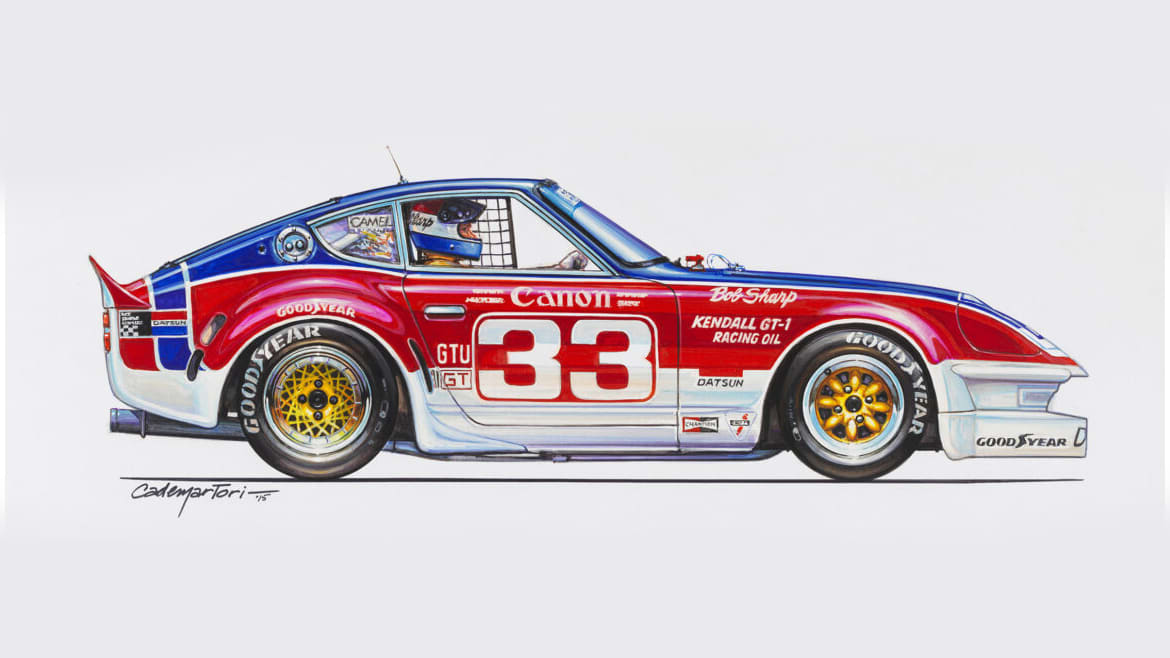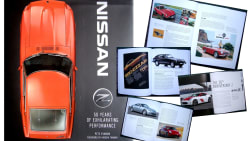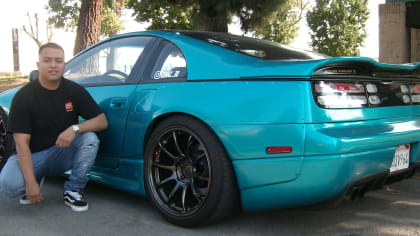The Iconic Bob Sharp

Interview With The Iconic Bob Sharp And Him Racing The 1975 Datsun 260Z
Enjoy part two of the LACar ExtravaganZa with Datsun legend Bob Sharp as he details his adventures in his distinguished #33 Datsun 260Z GTU car.
By Hector Cademartori
Wed, Sep 23, 2020 12:00 PM PST
Editor's note: The gorgeous artwork at the top of this article was painted by Héctor Cademartori, the ringleader of our ExtravaganZa. To see more of his work, check out HectorCademartori.com.
This article is a part of
Nissan Z ExtravaganZa
Click to see the collection and all the included articles!
Some individuals need no introduction on planet DATSUN. Bob Sharp is one of them and the first car in our series of significant Datsun/Nissan racecars is one from Bob’s racing stable, the iconic red, white and blue #33 250Z GTU. Yes, a 250Z, it’s not a typo. Bob likes to say that it was the only Datsun 250Z ever produced since Z’s were badged according to the engine displacement.
Bob Sharp’s driving career ended in 1976 at Lime Rock, when he broke his wrist in a crash. He continued running the team from which several top drivers began their careers, including Jim Fitzgerald, Sam Posey, Elliott Forbes-Robinson and a Connecticut neighbor and aspiring driver known around Hollywood as Paul Newman.
Producing this piece of artwork gave me the opportunity not only to learn about the history of this particular car but, also, about other aspects of that racing operation, straight - as they say - from the horse’s mouth:
Q: When did you build this car?
A: “There were 2 cars built in 1974. One was the GTU car that you illustrated [featured above] that raced in the Camel GT series, and the other was a C-Production for SCCA. The GTU car, as well as all of my cars, was first tested at Lime Rock before entering a race because that track was in my own backyard, here in Connecticut.”
The team entered the car in the 1975 Camel GT Challenge which was the 5th season of the IMSA GT Championship series for GTO (over 2.5 lt.) and GTU (under 2.5 lt) Grand Touring racing cars. It began February 1st and ended November 30th after 17 rounds, some of them double-headers. Bob ran in 10 of them and won every race: Road Atlanta (twice), Laguna Seca, Riverside (with Walt Maas), Lime Rock (twice), Mid Ohio (twice, one with Jim Fitzgerald)) Mid-America and Daytona. The team did not enter the other seven that included Daytona (24 Hrs), Sebring (12 Hrs), Laguna Seca, Mosport, Daytona, Mid-Ohio and Talladega.
Q: Why did you not enter the long distance races, Bob?
A: “Back then races were 1, 2, and up to 6 hrs in duration. We did not run in the 12 or 24 hr events mainly because they didn’t pay any better than the others. The prize money was very little anyway so why put your car through all that. I considered a 6 hr event to be an endurance race."
Q: What else can you tell us about the GTU car?
A: "The car weighed about 2400 lbs and had a 50/50 weight distribution front to rear. You could drift that Z at 120 mph through the apex of a turn with ease. I can tell you that this was the best racecar I have ever driven in my career. Porsche lobbied IMSA to allow cars to run 15” rear tires since their cars tended to be tail “waggy” due to the power and engine being in the rear and this would give them a better balance with the wider tires, but this also made the Datsuns better as well. The Z drove like a slot car. After the championship year, I started the 1976 season in the third race at Road Atlanta and had a big crash. At the time of the wreck, I was 14 seconds ahead with 7 laps to go, but coming down the straight away at 152mph, the car had a fast flat in the dip and spun backwards hitting the embankment. It was totaled but, fortunately, I walked away without a scratch. This was the end of the car that you illustrated so we took the C-Production Z and converted it to a GTU. [Note: With this car Bob had his accident two months later at Lime Rock where he broke his wrist. The car was repaired and raced again. It won only once that year in Pocono with Elliot Forbes Robinson at the wheel]. The badly damaged original GTU was stripped of all the parts that were usable and we used them on future racecars."
Q: You were the Datsun Team on the East Coast and Pete Brock’s Brock Racing Enterprises (BRE) was the Datsun team on the other side of the country... How was your relationship with BRE?
A: “Peter and I were friends back in the racing days, but competitors just the same. I used to race out west at Riverside (back when the SCCA runoffs alternated races between Riverside and Daytona) and being from back east, Nissan wanted a west coast team that could compete as well. They gave Peter one year to build a racecar. In those days it was unheard of. We usually had to put a car together in 3 months! I invited Peter to Watkins Glen in the late 60’s to see our roadsters race. . I remember that Peter wanted us to use a Spook front spoiler which was his original design, but we never did."
[Note: I was actually a guest driver for BRE in the early 70’s and drove a 510.]
Q: And how was your relationship with Nissan Japan? Did you get any technical help from them?
A: “Japan had no clue what kind of racing was going on in America. When they did try to send parts, they didn’t have any practical use on the racecars so we never used them. The Japanese could not believe that a private company could put together a winning race team and never even bothered to come in person to see what the American teams were doing."
Q: Do you recall some of the main specifications of this 1975 GTU?
A: “The main figures were: put out about 320hp with 3 Mikuni Solex carbs. We used Blue Sunoco pump gas. It had a 5-speed close ratio transmission and a LSD 4.11 to 5.12 depending on length of track. The brakes were fitted with air ducts, 12” front tires and 15” rear tires. The car weighed about 2400 lbs."
Q: What is your fondest memory of those days with this Z?
A: "The big thrill for me was being able to take a Datsun, that most Americans weren’t even aware of, and go out and beat the big boys of that time, Porsche, BMW and Alfa Romeos, which not only surprised them but also the general public. We took a lot of pride in that. But, also, that 1975 championship was instrumental in advancing the Datsun/Nissan Racing division. I give a lot of credit to Gene Crow and our team for developing the GTU car of 1975."
About The Author

Hector Cademartori honed his racing art in Buenos Aires. In 1983, he left his job with Corsa Magazine in Argentina and moved to Southern California to specialize in motor racing art. Today, you can find Hector’s art on Indianapolis 500 Yearbook covers, Laguna Seca Raceway, Auto Club Speedway and Carrera Panamericana posters, the NHRA, foreign and domestic automobile and motorcycle magazines, motorcycle manufacturers, Toyota Motorsports, TRD and Lucas Oil. Hector races his 1973 Datsun 240Z “Ferratsun” around the So Cal circuits, and a 1991 Volvo 740 Wagon with the 24 Hours of LeMons.






